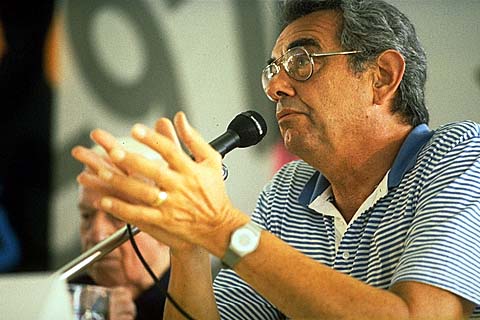Costantino Nivola
‘Despite his having left: with his works a deep impression both in America and Sardinia, the two poles of an artistic activity that has gone from architecture to sculpture to painting, often so intertwined as to make it difficult to formulate precise defini-tions, the figure of Costantino Nivola has never yet been the subject of a profound critical study. Born at Orani (Nuoro, Sar-dinia) in 1911, Nivola underwent his artistic formation in that ve-ry special and stimulating envi-ronment which was the Monza Art School in the 20s and 30s. After having been director of the graphics department of Olivet-ti, in 1938, Nivola moved to Long Island where he lived un-til his sudden death in 1988. A great freedom of expression and an uncommon sense of form which led him to choose diver-se and difficult materials – sto-ne, bronze, wood, concrete – and to keep alive that memory of Sardinian art and craft are cha-racteristic of his sculptures in which abstract form and strict linearism go together. The Meeting exhibition compri-ses 51 works of the Sardinian ar-tist from Pietrasanta (a town near Lucca where Nivola used to stay and work for some months each year in the company of fellow-sculptors) and the Wa-shburne Gallery of New York. These include 19 mothers (of which 17 in mirable, one in bronze and one in wood) 12 small bronzes (30 cm high) representing the craft of Sardinia, 10 terra-cottas on the theme, ‘The Beaches’ and another 10 dedicated to ‘The Beds’. The theme of the female figure pursued at different times and from different points of view by the artist, links Nivola to ance-stral memories and to the an-cient female figures of Sardinian Mediterranean culture. ‘The Mothers’, ‘The Crafts of Sardinia’, ‘The Beaches’ and ‘The Beds’- represent the intimate, and we could say existential and reli-gious dimension of Costantino Nivola’s production against which stand the great works of social commitment such as the monuments to the Sassari Bri-gate and Antonio Gramsci or the immense project for the comple-tion of a monument to the Ame-rican Flag. In one hall of the Ri-mini exhibition a series of large photographs by Giorgio Vettori will be on display showing the Piazza Satta at Nuoro after its re-designing by Nivola. ‘On examining the great variety of Nivola’s sculptures and the evident readjustments made between the need for often conflictual spon-taneousness and conceptual di-scipline’, writes Fred Licht, ‘one might think that a paradoxical element exists in Nivola’s art’. This impression stems principai-1y from the vast range of sub-jects which are sometimes lyrical and sometimes hierarchically monumental. In Nivola’s evo-lution, constant factors do exist however. One of the most impor-tant is that spirit which is never frivolous and which highlights the essential honesty of every-thing he does”. The exhibition will be accompanied by a cata-logue specially prepared for the ocasion.’




